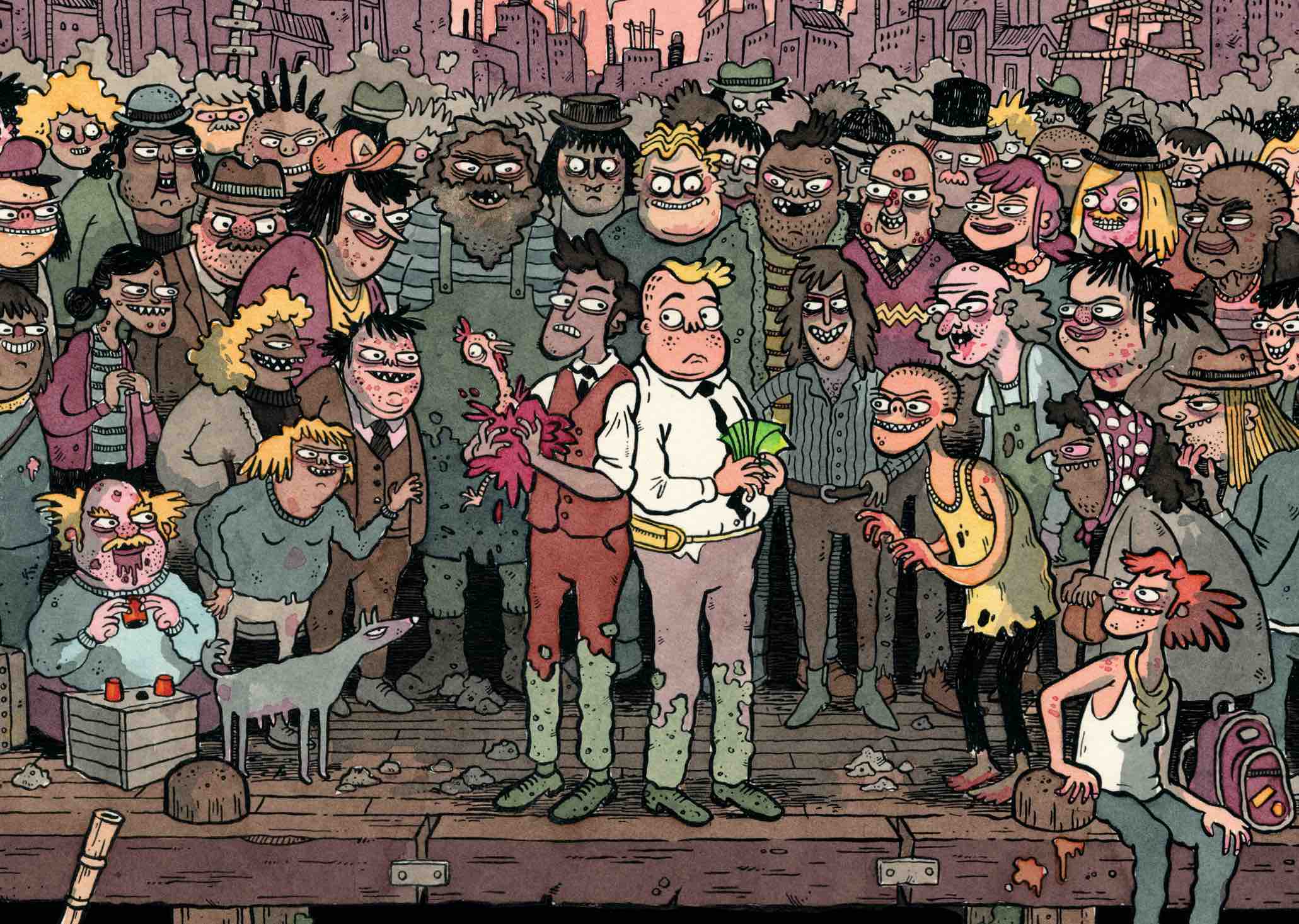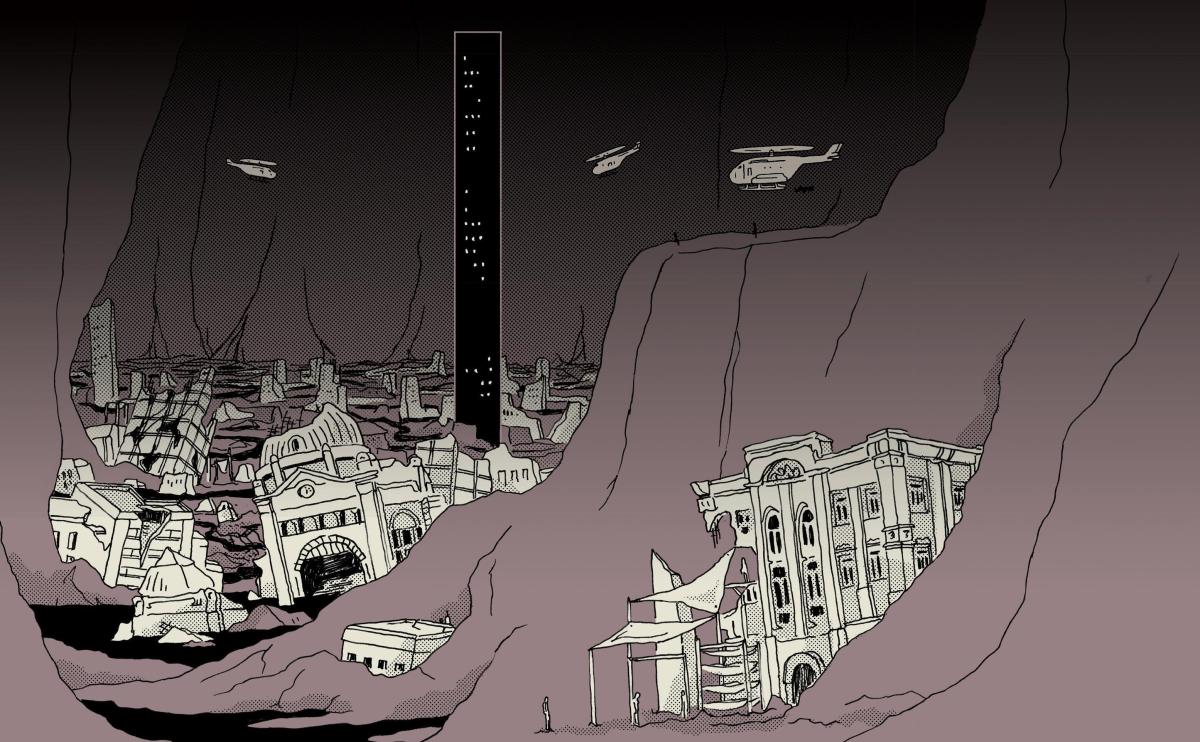A pair of young hopefuls enter a stinking, post-apocalyptic port town. Three young women of colour are screamed off a bus to the deafening silence of the other passengers. Five primary school children face off against angry dragons in an alien arena. A Hazara asylum seeker dies in custody at the Villawood Detention Centre in 2013.
Welcome to Australia.
Welcome to the Australias on show in some recent Australian comics and graphic novels.
As has been the case for the last couple of decades, there’s plenty going on in the murky underworld of Australian comics culture: creators keep cranking out zines and comics and graphic novels, but for the most part, those creators go on to publish the books themselves, bearing the brunt of printing costs, the effort required to get the word out about their work, and the shoe leather worn away in distribution (i.e. lugging boxes of books from shop to shop). Self-publishing is a necessary part of the comics ecosystem, but in order for books to reach a wider audience, and particularly to reach those readers who don’t inhabit the lovely but funny-smelling comics ghetto, actual third-party publishers are a vital addition to the comics biome.
Australians invading the world
One way of ensuring ‘proper’ publishing (the ability to have a sizeable number of copies printed to drive down unit price, the marketing capacity to let potential readers/buyers know about the book, and pre-existing arrangements with distributors to ensure that copies land on as many bookshop and library shelves as possible) is to get your graphic novel published overseas.
In the last few months, North American comics publisher Top Shelf Productions have released three (count ’em! THREE!) graphic novels by Australian comic book makers. Top Shelf (distributed through Penguin Random House in Australia) has published previous books by each of these creators: Pat Grant from New South Wales, Chris Gooch from Victoria, and Campbell Whyte from Western Australia, but the almost simultaneous triple-header release of the new books was trumpeted by Top Shelf in November 2020 as ‘The Australian Invasion’.
Grant’s The Grot is a graphic novel set in a climate-disaster ravaged Australia. Infrastructure and even mechanical know-how has broken down, such that all vehicles are powered by banks of under-paid cyclists, as per the slaves who rowed galley ships. To the enormous slum metropolis of Falter City (the name clues us further into the broken-down state of things) come the brothers Penn (the smartarse) and Lippy (the rube) in order to make their fortune. Hilarious, dreadful hijinks ensue. Grant’s loose, easy cartooning approach is as belied by Fionn McCabe’s murky, delicate watercolours as by the horrific dog-eat-dog ethos of Falter City.

Cover detail from The Grot by Pat Grant.
Gooch’s Under-Earth also drops us into a dystopian future. His stark black and white cartooning describes a vast underground cavern prison and its denizens in gritty, violent tones. His visual style means that the brutality of the Under-Earth world is more overt than in The Grot. He uses a yellow background spot-colour to designate the storyline of Ele and Zoe, a pair of thieves looking for a way out, and a grey-purple colour for the backdrop to the story of Reece and Malcolm, prisoners whose survival within the bloody might-is-right world of the prison will depend upon one another. The only other colour that Gooch deploys in the book is red. Blood red.
Read: Koori comics culture is thriving
Campbell Whyte’s Home Time II is the second volume of a two-volume tale set in his home town of Perth. In the first book, on the last day of primary school, a group of five friends fell through a river and on the other side found themselves in a world populated by little creatures, the Peaches, who regarded the kids as magic spirits, and whose village came under attack by vicious lizards. One of the kids got badly burned, and this new volume details the quest by the remaining four children to find a cure for him on a journey through this upside-down Australia.
Whyte, a cartooning chameleon, changes his style for different sections of the book to reflect the perceptions of the focus character. These gorgeous, full-colour hardbacks offer deeply immersive storytelling in a world which is part fantasy novel and part video game, all filtered through a local lens which references distinctive Australian fauna and flora (i.e. marsupials, proteas) to create a fantasy world which is both Other and resolutely Here.
Homegrown comics hold their own
Locally, Brow Books has been a committed publisher of comics and graphic novels alongside illustrations and words-only texts. In 2017 they published the established comic book maker Mandy Ord’s book When One Person Dies the Whole World is Over. The schema for When One Person Dies is that each page presents a one-day four-panel comic, and the whole book tells one year of Mandy’s life. That’s right – 365 pages, each page sculpting a mini-story, in Mandy’s signature thick black ink lines, out of the events of a single day.
One of the beauties of this book is reading it for the themes and patterns that emerge out of the messy stickiness of Mandy’s daily life. This graphic novel is an epic and intimate love letter to ordinary (see what I did there?) life, and was nominated for a Stella Prize and SPN’s Book of the Year in 2020.
Read: Ten of Australia’s best literary comics
Claudia Chinyere Akole’s 42-page comic Why Black Lives Matter Resonates With Black People All Over The World: An Open Letter to Australians was published digitally by Going Down Swinging in August 2020. The comic, as Akole says, is ‘an exploration of global Black Solidarity that compares ongoing Bla(c)k Civil Rights movements in the USA and Australia’ and she uses the direct-address of the letter format to address the reader and the neon-boldness of her graphic approach to ‘throw a pebble into the pond of white opinions on race in Australia’.
In April 2021, Melbourne graphic novel publisher Twelve Panels Press will publish Safdar Ahmed’s Still Alive: Notes from Australia’s Immigration Detention System. (Full disclosure: I am one of the co-publishers at Twelve Panels Press.) Still Alive is an expanded, print version of Ahmed’s Walkley Award-winning webcomic Villawood: Notes from an Immigration Detention Centre.
The book tells the story of Ahmed’s visits to Villawood and the Refugee Art Project which he helped to run there. Out of that project came artworks from asylum seekers, which see print in the book, and Ahmed’s comics narrative which tells the stories of life inside the detention centre, and the life stories of the refugees themselves. A heavy metal and horror buff, Ahmed’s narrative also explores how the making of art can help a person deal with trauma. His realistic black and white art style gives voice to people’s stories and encourages empathy with the protagonists.
So there you have it: comics are getting out and amongst it, using the visual capacities of the artform to explore and critique the Frankenstein’s monster that is Australia. Examining its glories (beautiful plants and animals) and its diseases (entrenched racism, environmental collapse, political cowardice, humanitarian failure), Australian comics makers are telling stories in words and pictures to inspect the piecemeal beast that we inhabit, snout to curly tail.
Equal parts words, pictures, lettering, colouring, layout, outrage, amusement and disgust, comics are a mongrel artform for a mongrel country.





